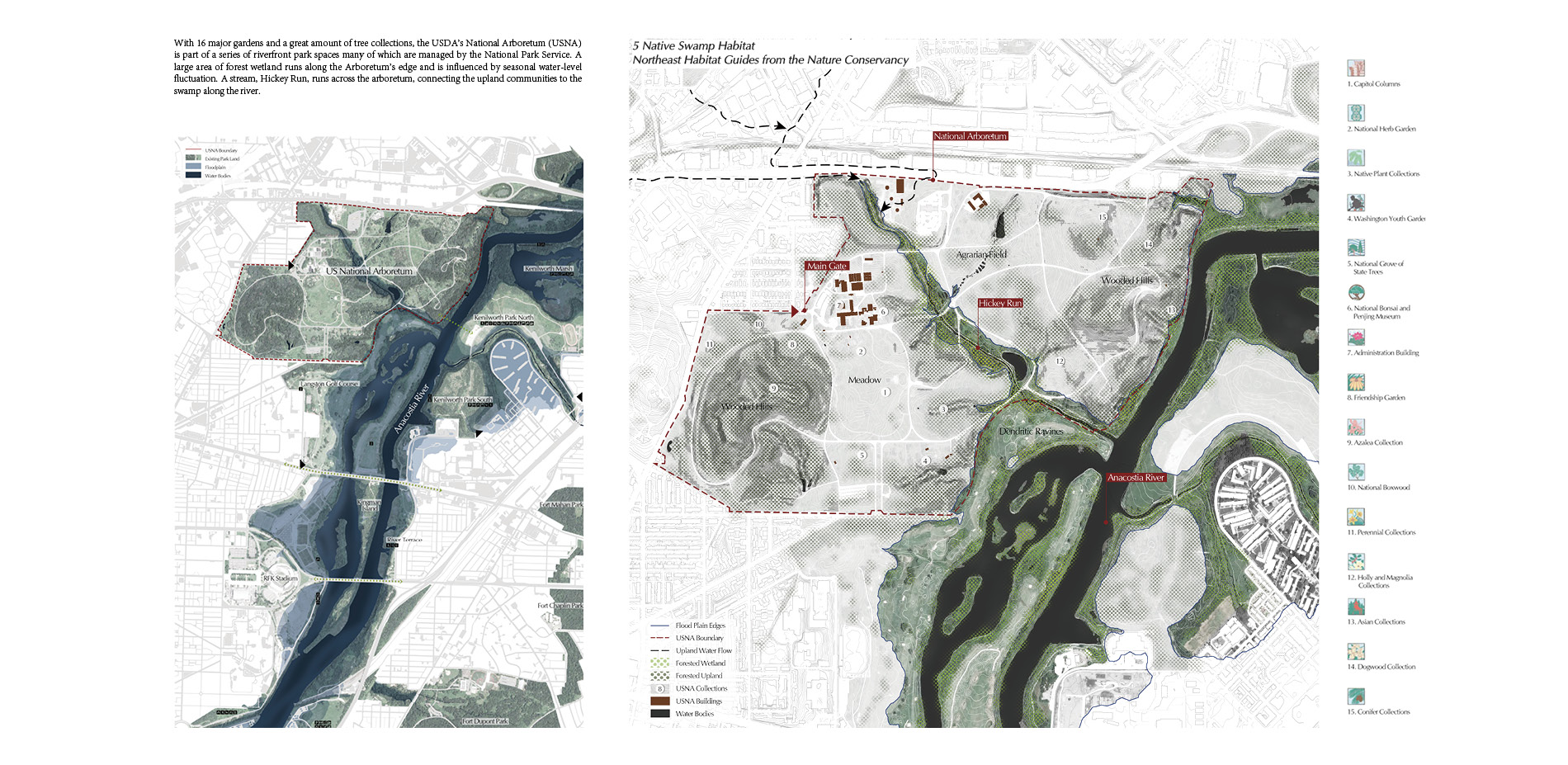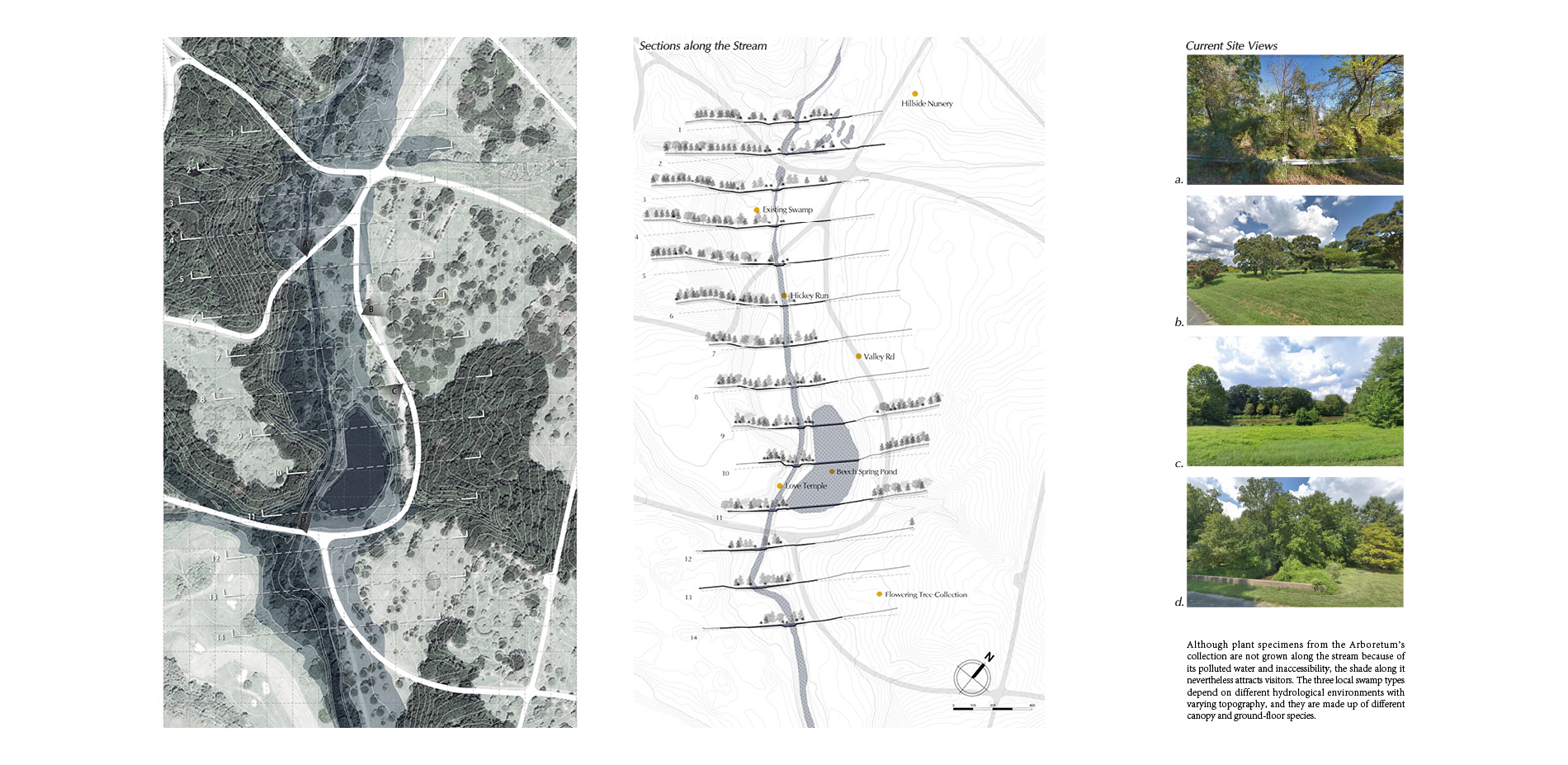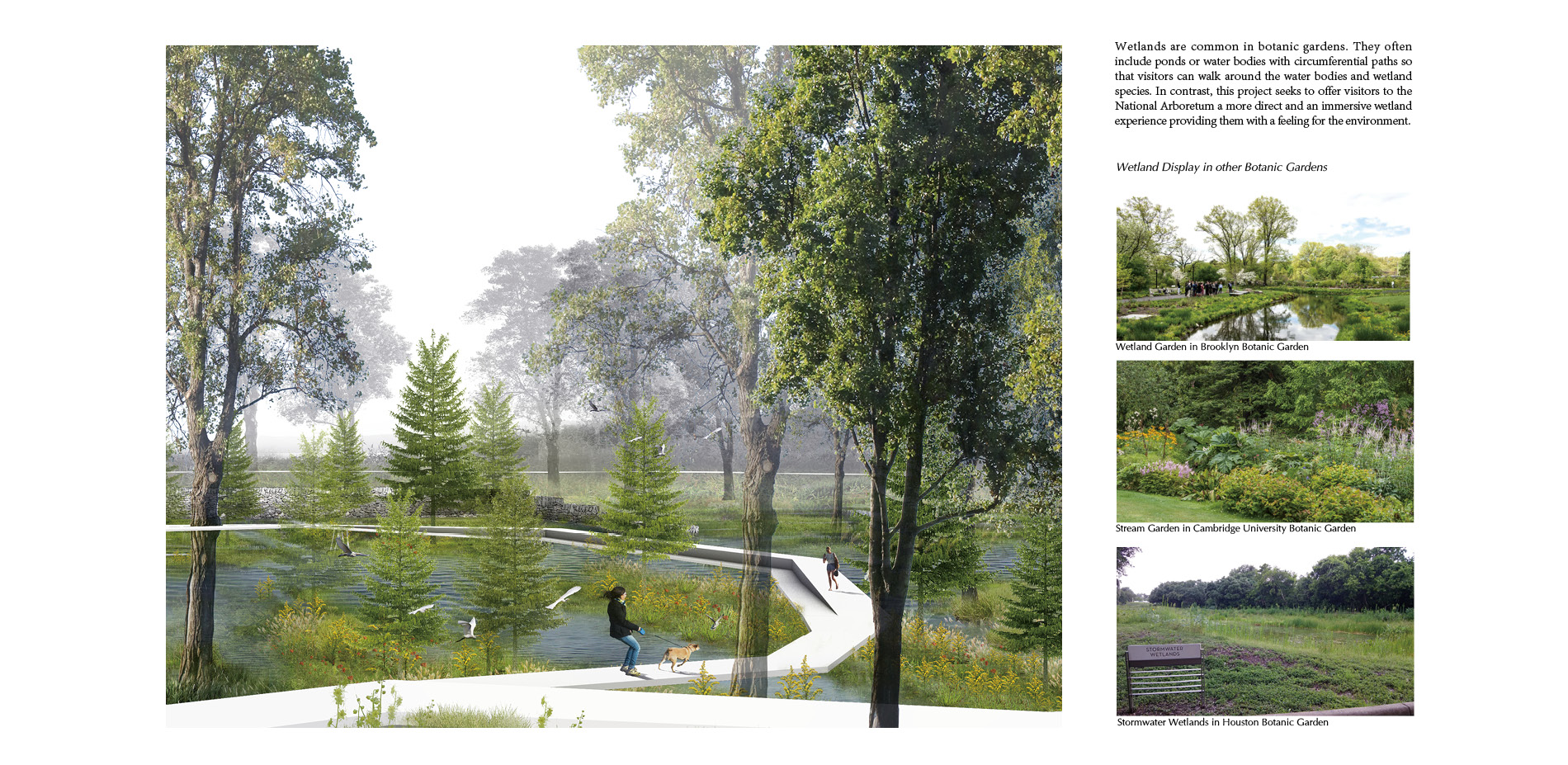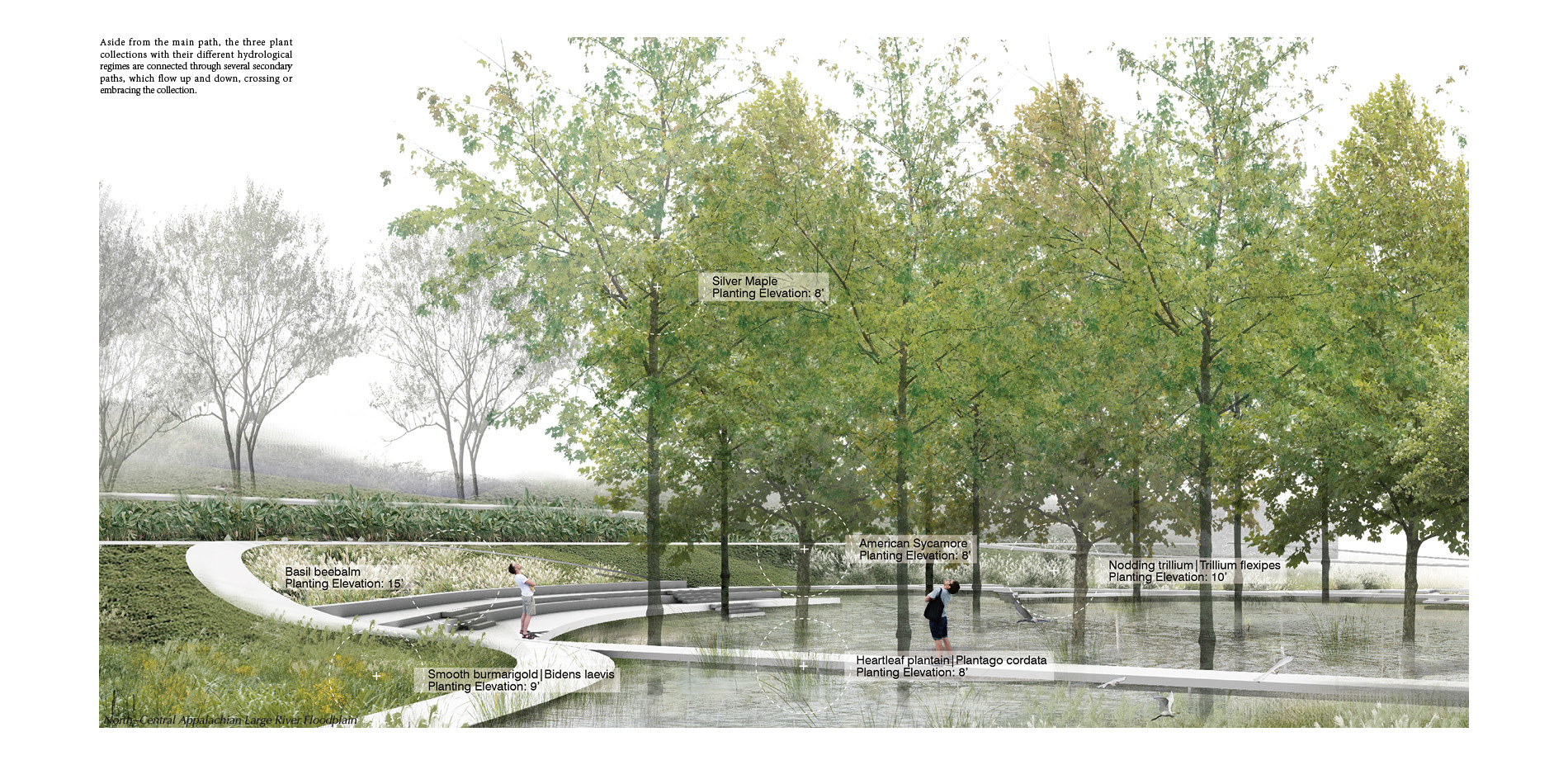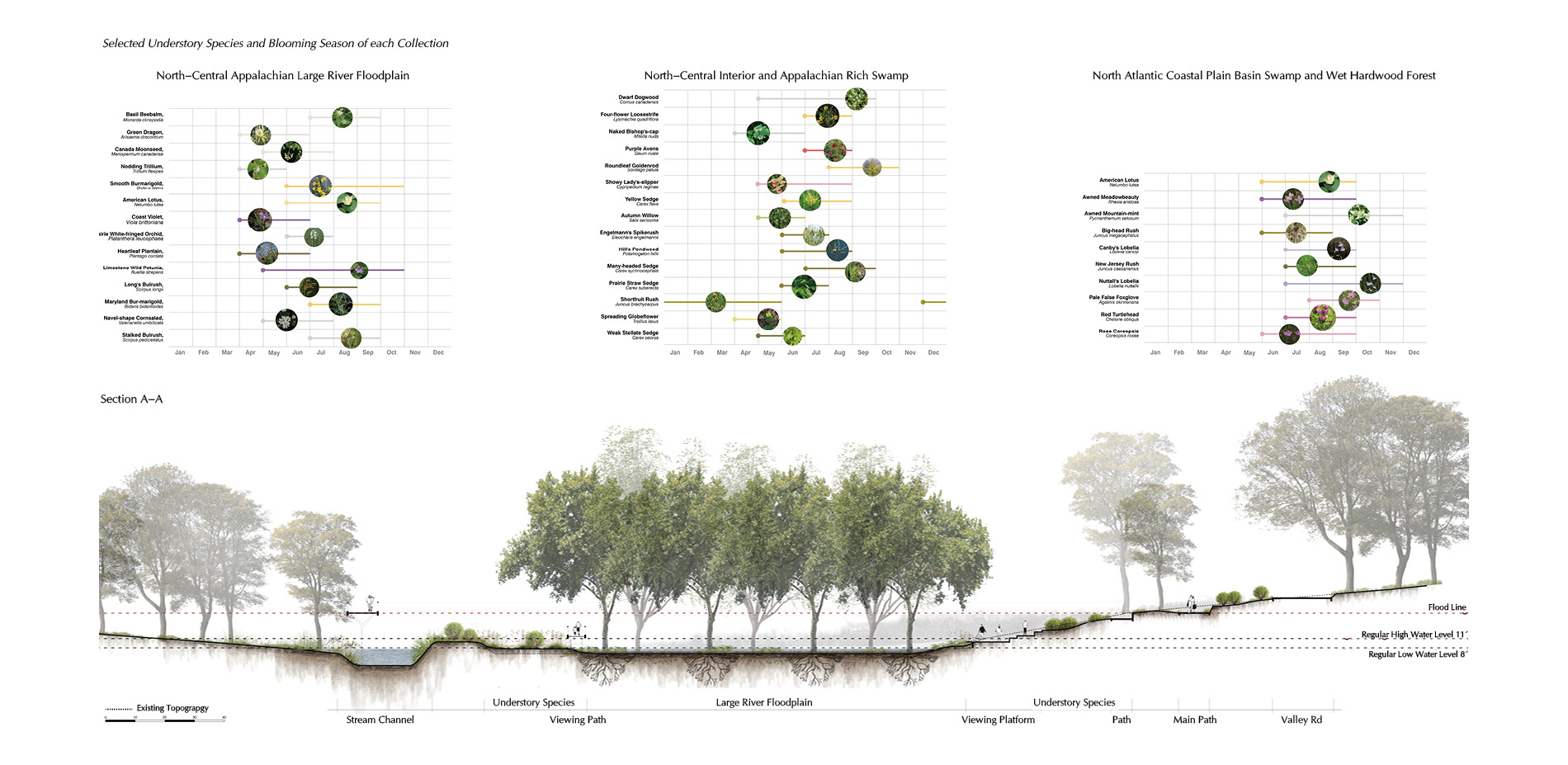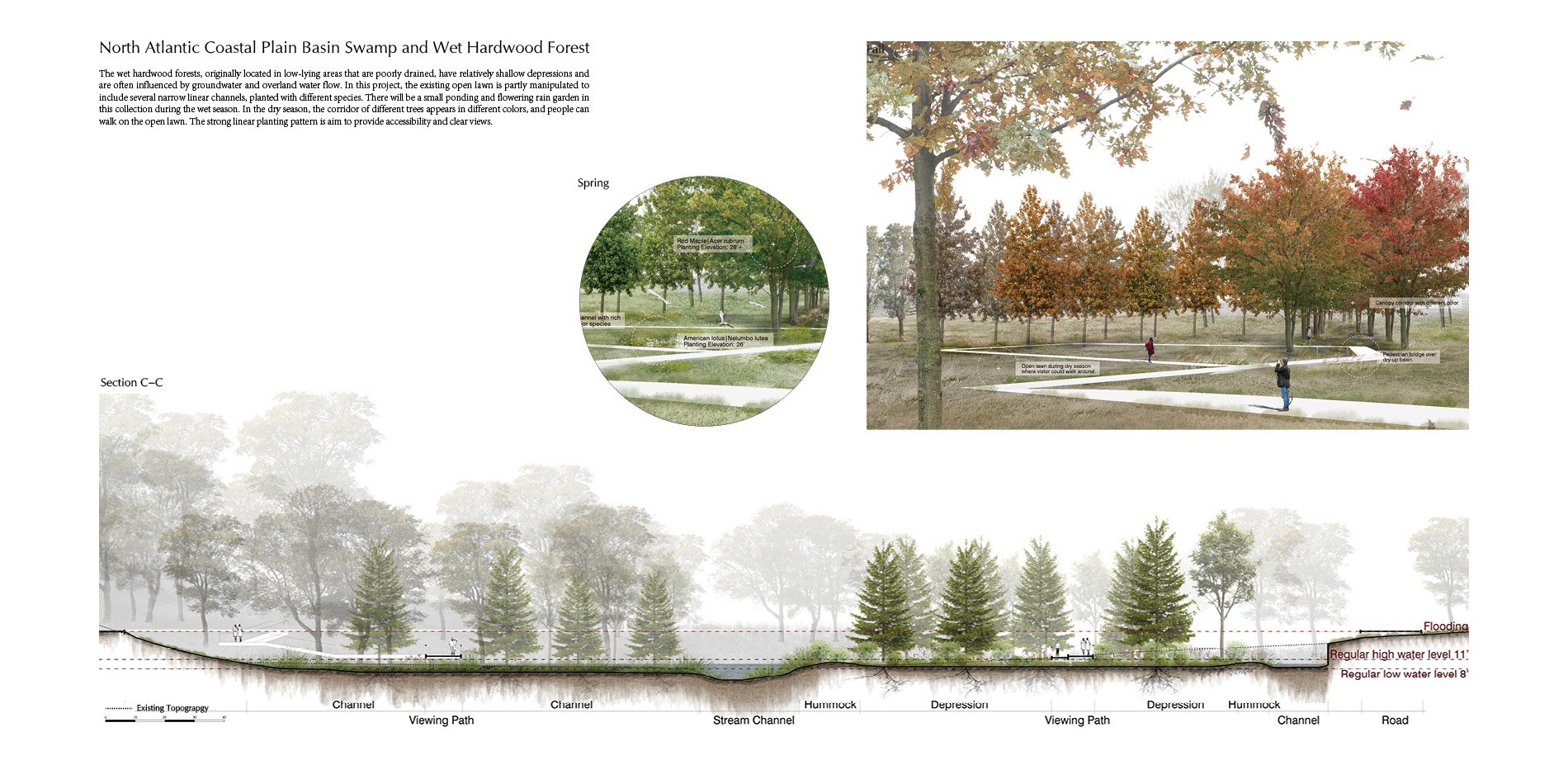Arboretum Within Wetland
Honor Award
General Design
Washington D.C., District of Columbia, United States
Wenqi Yang, Student ASLA;
Faculty Advisors:
Karen M'Closkey;
University of Pennsylvania
The evocative imagery beautifully conveys the character of a landscape that looks simple but is actually richly complex.
- 2022 Awards Jury
Project Statement
One crucial role that botanic gardens play is to collect species that naturally grow together and constitute the identity of a certain environment. It portrays a particular biotope through the display of particular plant species and encourages visitors to observe the various plant communities.
The National Arboretum is located on the west side of the Anacostia River, surrounded by natural wetlands. However, these areas are isolated and not easily accessible to locals and visitors. The wetlands along the Anacostia River are invisible, inaccessible, and their size continues to decrease. Wetlands are common components of botanic gardens. There are often displayed as ponds or water bodies with circumferential paths. However, to educate people about wetlands, it is important to provide them with more direct and immersive experiences of this biotope type so they can feel the environment as a whole.
This project provides this immersive experience in different wetland collections, dominated by native trees and supported by a natural hydrological system.
Project Narrative
"Botanic gardens, which combine the science of botany and the art of display to educate the public about plants, are a useful lens through which to understand our changing relationship to nature, plants, and plant collections, as well as their representations." (Studio Syllabus, 2021)
Rolf of Botanical Gardens:
One crucial role that the botanic garden is playing is to collect species that naturally grow together and constitute an “identity card” of a certain environment. This proposal seeks to visualize the environmental identity of the National Arboretum (USNA) and its regional environment through display, interaction, transition, observation, and education.
Site:
Established in 1927 by an Act of Congress, USNA was located on a 446-acre site along the Anacostia River two miles east of the US Capitol. With 16 major gardens and numerous tree collections, it is a leading horticultural science institution and part of the Agricultural Research Service of the US Department of Agriculture.
Within the Anacostia Watershed, Forests and wetlands cover a large area along the riverfront, but there is about 90% wetland loss because of the urban surface runoff and industrial pollution. The existing inaccessible forested wetlands, which are also referred to as swamps, are a representative biotope in the region, also making up parts of the National Arboretum. According to the Northeast Habitat Guides, there are 5 types of native swamp habitats that can be found in DC, and three of them have the potential to develop within the grounds of the National Arboretum.
With 16 major gardens and a great amount of tree collections, the USDA’s National Arboretum (USNA) is part of a series of riverfront park spaces many of which are managed by the National Park Service. A large area of forest wetland runs along the Arboretum’s edges and is influenced by seasonal water-level fluctuation. A stream, Hickey Run, runs across the arboretum, connecting the upland communities to the swamp along the river. Although plant specimens from the Arboretum’s collection are not grown along the stream because of its polluted water and inaccessibility, the shade along it nevertheless attracts visitors. The three local swamp types depend on different hydrological environments with varying topography, and they are made up of different canopy and ground-floor species.
Concept:
Wetlands are common in botanic gardens. They often include ponds or water bodies with circumferential paths so that visitors can walk around the water bodies and wetland species. In contrast, this project seeks to offer visitors to the National Arboretum a more direct and and immersive wetland experience providing them with a feeling of the environment.
This proposal envisions three different plant collections representing 3 local swamp habitats and uses the Hickey Run as the major display area where water fluctuates seasonally, and the surrounding floodplain with its existing swamp species and various soil humidity provides for various visitor experiences.
To create an immersive experience that better represents the character of each collection, this project refers to the texture of nature, including water flow, soils, and plants. The patterns extracted from soil erosion and wood grain are manipulated into a symbolic shape. Following the existing topography and elevation, this pattern helps create an internal hydrological system that collects water upstream and retains moisture on the site. Cross-stream strips connect the higher ground with the river’s edge and allow visitors to move between the two as well.
Strategies:
1. Main Circulation to Distinguish between Wet and Dry Environments
Existing forests are located on one side of the stream. This project proposes a horizontal main circulation above the highest water level, elevation 20’. The idea is to give people a clear sense of the moisture and saturation of the environment when they walk along the path. Visitors can walk through existing fresh-water and salt-water swamps, as well as new plant collections. Also, the path is connected to the existing road network to ensure accessibility.
2. Manipulated Hydrology System to Provide Preferable Growing Environments and Humidity
The three collections’ organization is based on the respective elevation at which these swamp habitats prefer to grow. Original topography is partially manipulated to drain and collect water, especially providing a wet condition in the upland area for a wet hardwood forest. The cut and fill allow water to flow and sediment to deposit along the stream in the proposed direction and create a nutrient-rich space to grow both canopy and understory.
3. Interactive Wetland Experiences and Seasonal Performance
Aside from the main path, the three plant collections with their different hydrological regimes are connected through several secondary paths, which flow up and down, crossing or embracing the collection. In addition to this, seasonal changes in plants and water levels make the display, as well as the ecological system above and underground, more dynamic. Both the canopy and its understory present different color patterns in different seasons.
4. Functional and Educational Effects on Local Environment
This design proposal is not only creating a botanic display; it also is a project for environmental mitigation along the stream and the Anacostia River. By planting these wetland habitats, this project helps restore the ecological system on both sides of the stream, increasing the biodiversity of the shoreline. As part of the National Arboretum, it also serves as an educational model for waterfront mitigation measures within the Anacostia Watershed.
Collections:
North-Central Appalachian Large River Floodplain - The extent to which the floodplain is under water varies with the seasons. At the lowest elevation, it is mostly underwater. Selected dominant canopy species including silver maple and sycamore grow along the edge of or within the shallow pond. It ponds during spring and summer. Flowering groundcover species are planted on the terraced bank, in contact with water under the canopy. During the fall with its low water levels, the pond becomes a muddy basin. Some trees may topple because of the flooding in the wet season.
North-Central Interior and Appalachian Rich Swamp - Swamps are usually wet or flooded for part of the growing season but not completely saturated for too long. They have both small hummocks and depressions to create nutrient-rich conditions. The plant collection disperses crossing the stream. Responding to the biotope’s character with hummocks and depressions, sub channels are created on both sides to provide an environment for luscious vegetation. Walking on the designed path, people experience this rich groundcover. The density of groundcover species is related to the canopy above.
North Atlantic Coastal Plain Basin Swamp and Wet Hardwood Forest - The wet hardwood forests, originally located in low-lying areas that are poorly drained, have relatively shallow depressions and are often influenced by groundwater and overland water flow. In this project, the existing open lawn is partly manipulated to include several narrow linear channels, planted with different species. There will be a small ponding and flowering rain garden in this collection during the wet season. In the dry season, the corridor of different trees appears in different colors, and people can walk on the open lawn. The strong linear planting pattern aims to provide accessibility and clear views.
Plant List:
- Silver Maple
- American Sycamore
- American Larch
- Black ash
- Red Maple
- Sweetgum

